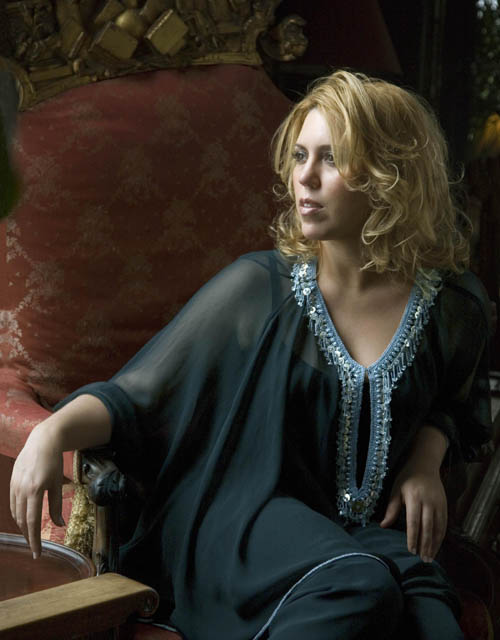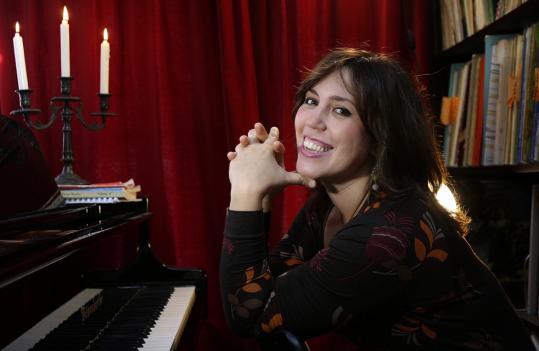Classical Perspectives
Gabriela Montero Cuts a Swath Through 100 Years Of Latin Classical Music
Let's face it, most people don't think of Latin America when they think of classical music. And neither do they envision even major composers from Brazil, Cuba, Venezuela or Argentina taking a seat alongside Beethoven and Brahms any time soon.
But a growing number of Latin American musicians seem determined to address this. Among them is the Venezuelan pianist Gabriela Montero, whose latest recording, Solatino, offers inspired performances of 26 short, luminous works by seven Latin American composers.
Born in Caracas in 1970, Montero emerged on the scene in the last decade with several engaging and at times quirky recital recordings and an international concert diary that included an appearance at President Barack Obama's inauguration, playing alongside Yo-Yo Ma, Itzhak Perlman and Anthony McGill.
Gabriela Montero plays excerpts from Piano Sonata No. 1, op. 22. Alberto Ginastera, composer. From the new album, SolatinoThis, her third solo album, cuts a swath through 100 years of Latin classical music and begins in the middle, in the mid-20th century, with Ernesto Lecuona, the so-called Gershwin of Cuba. Lecuona wrote 11 film scores in the 1930s and ‘40s, and that experience seems to inform the colorful and expressive style of the short piano works featured here. Chief among them is the mambo-tinged “La comparsa” and the gorgeous “Malagueña.”
At the opposite end of the stylistic spectrum is Alberto Ginastera's “Piano Sonata No. 1,” a bold and challenging exploration of Argentine rhythms, and featuring a rather modernist harmonic language, carefully bent and shaped by Montero. The delicate third movement and the final rondo of the fourth movement aptly demonstrated her commanding technical skills.
"I have been playing it a lot in the last few years," says the artist. "I actually learned it while I was studying at the Royal Academy of Music with Hamish Milne but it has been with me most of my life; it is music that has great significance for me because, of course, I am Latin."
The four-movement Sonata No.1 was composed in 1952 and is generally considered to be Alberto Ginastera's masterwork for the piano, demanding incredible virtuosity. "The Ginastera sonata is a very enigmatic and at times mysterious and violent piece, very animalistic," says Montero. "In that respect it's a different sound on the recording." The sonata makes enormous demands of the performer and uses to the full the rhythmical and tonal possibilities of the instrument.
Other composers on the album mix the sounds of European masters (the French impressionists in particular) with elements drawn from Latin American nationalism and popular song. We hear this especially in excerpts from “Piezas infantiles” by the Argentine Antonio Estevez and five salon-style pieces by Brazilian composer Ernesto Nazareth.
Finally, among Montero's trademarks is a knack for improvisation. Once a fairly common skill among classical musicians (Mozart and Beethoven were both legendary improvisers), today it's mostly gone from the classical ethos, as musicians became more concerned with fidelity to the score. This recording includes five short improvs, each infused with a supercharged Latin romanticism, the best being “Mi Venezuela Llora.”
(this review contains excerpts from WQXR.org's Album of the Week review)
Gabriela Montero’s Solatino is available at www.amazon.com
***
Gabriela Montero: ‘As you develop as an artist, and become more in tune with your voice, and it becomes stronger, improvisation stays as part of all of that. As a consequence, my improvisation has become more complex and intricate, more mature.’ (Photo: Sheila Rock)The Secret of Gabriela Montero's Improvisations
By Stephen Pettitt
(Excerpts from a February 3, 2008 interview published in The Sunday Times of London)
In one form or another, the act of improvisation—of simultaneously composing and performing on the hoof—has a history as long as that of music itself. From the improvised vocal polyphony, called discantus, of medieval times to the extravagant exhibitions of Chopin and Liszt in the salons of 19th-century Paris, artists have happily made it up on the spot. It's an ability on which jazz musicians depend, but it's rare for a classical artist to make improvisation a cornerstone of a career. That's what the Venezuelan pianist Gabriela Montero has done. Her recitals nowadays are half repertoire pieces, half improvisation. It is both what is expected and what she prefers.
She has always improvised, from when she began playing the piano as a small child in Caracas. "It was something very natural, my way of exploring the piano," she explains. "Somehow it always made sense to me. When I was younger, they would always be 45-minute pieces, extended fantasies, you know. It was like playing out fairy tales, inventing characters." Was there any feeling this was something she had to work on, to refine? "In my case, I don't believe I can refine it. As you develop as an artist, and become more in tune with your voice, and it becomes stronger, improvisation stays as part of all of that. As a consequence, I think my improvisation has become more complex and intricate, more mature. But I've never sat down and said, 'I'm going to work on my improvisation.'"
What about shaping a piece? Does she, for instance, consciously craft some of her improvisations in ternary, A-B-A form? "I don't do any of that. I've never studied analysis or composition, or harmony and counterpoint. What I do comes from an instinctive viewpoint, without intellectual planning or reasoning. The reason I chose not to study those subjects, a flagrant heresy in the classical world, was perhaps to preserve that purity, that non-thought when I improvise. I wouldn't be able to tell you if I go from A to B to A, because I just don't know!"
Martha Argerich and Gabriela Montero duet on Paganini Variations by Lutoslawski. Argerich, a major personal and professional influence on Montero, didn't as much encourage the young pianist to embrace improvisation in her concerts as scold her for not having done so before. ‘She sort of called me stupid,’ Montero recalls.Hold on, what's happening here? Montero is telling me that she doesn't have a clue what is going on when she improvises? "Yes. When I improvise, there's nothing. Absolutely nothing. It's like jumping off a cliff."
Scary, then. "No! I love it. It's absolute, complete freedom. There was nothing before and there will be nothing after. It exists only for the purpose of communicating something at that moment."
She surely, then, at least avoids the danger of finding herself off track in the middle of an improvisation by thinking ahead. "But there's no thought! I think what I do is hear the harmonies. I don't know what they are, I just hear them and play them. But I can't tell you what I've done after I've improvised. I have a sense of how I felt about it, but I wouldn't be able to play it back unless I listened to a recording of myself and copied it. My brain is in shutdown mode. It's very pleasing, actually!" And, by the sound of it, therapeutic? "Yes. When I think about it, it's almost like a cleansing."
We talk about the pianists she most loves. There is Martha Argerich, of course, a real inspiration on many levels, personal and musical, who didn't as much encourage her to embrace improvisation in her concerts as scold her for not having done so before. "She sort of called me stupid," Montero recalls with smiling fondness. The meeting at which this exchange occurred, in 2001, changed everything for Montero. A phone call from Argerich to the right people was enough.
Who else besides Argerich? Annie Fischer, Sergio Fiorentino, Boris Berezovsky, Hamish Milne (her teacher at the Royal Academy of Music). And, from older generations, Edwin Fischer, Rach-maninov, Vladimir Sofronitsky. "I went through a period when I listened a lot to the old pianists, and I fell in love with that way of playing." I ask if that infatuation was because so many of today's artists, shackled by the perfectionist demands of the recording studio, have sacrificed character and risk for the sake of getting it right.
"That's exactly the problem. That's why there's often this static feeling in concerts. Unfortunately, we have fooled ourselves into thinking that the artist is meant to be a god, and is meant to deliver exactly what you hear in a recording. Many artists are crushed by that. We're human. And, if I can do my bit to bring a little more humanity onto the classical stage, less perfection and more soul, more joy, well that's good. When did we lose the joy of playing classical music? It's almost like we have to suffer. Enough with depression!" Quite.
Stephen Pettitt's complete interview with Gabriela Montero is online at http://entertainment.timesonline.co.uk
***
An Improvised Moment with Gabriela Montero
By Norman Lebrecht
Improvisation, it is called, and it's a defunct art. It's what virtuosi used to do before records and radio made them stick to a program. Mozart freely improvised on his own tunes. Liszt would strike up an aria from a Wagner opera and decorate it. Ferruccio Busoni ruminated on a Bach theme, drawing wider and wider musical connotations. After the Golden Age (the title of Kenneth Hamilton's excellent new Oxford history of romantic pianism), that artistic license was suppressed. Gabriela Montero, born in Caracas, Venezuela, sees herself as its modern liberator.
We have reached the moment of truth. Gabriela and I are sitting in a piano maker's showroom in London where the grands are priced from £56,000 to £75,000. She gets a hard tone out of the first one she tries and shrieks “Ikea!,” collapsing in giggles.
Gabriela Montero on Solatino: ‘I think what’s wonderful about doing a recording of Latin American composers, right now, for me, is because in my life and in the history of my country it’s a very relevant period. So I like the idea of shining lights on this part of the world, where there is so much talent and where there is so much potential.’ Featuring the artist performing excerpts from the album.We find a better instrument and she asks me for a theme. I suggest the opening of Mahler's Fifth Symphony. Being a pianist, she doesn't know it. I sing a few bars. She doodles around a bit. We have a go at Brahms' clarinet sonata. Nothing much. But then I try the Beatles' song “Yesterday,” and she's flying.
She plays the opening line once and repeats the first three notes, before veering into a baroque set that could have been written by Haydn's younger brother. “Can you do another style?” I ask. “Name one,” says Gabriela. “Rachmaninov.” And she's off again, now into dark Russian chromaticisms that Paul McCartney would die to have in one of his requiems. The beauty of her invention is in the structure: every part of what she plays is perfectly weighted against the rest.
“Piazzola,” I demand and we have Beatles, tango-style. “I could do this all night,” she chortles. “I so love it. I come back from an airport, sit at the piano and clean my head with this.” She also improvises on demand for visitors to her website.
Gabriela has bought a house near Boston and, though single, seems happy. “I feel that what I am doing now,” she says, “has some importance. I want to widen the parameters of the concert. I love the look on people's faces when it's unexpected.”
(excerpt from the February 6, 2008 installment of The Lebrecht Report)
THE BLUEGRASS SPECIAL
Founder/Publisher/Editor: David McGee
Contributing Editors: Billy Altman, Laura Fissinger, Christopher Hill, Derk Richardson
Logo Design: John Mendelsohn (www.johnmendelsohn.com)
Website Design: Kieran McGee (www.kieranmcgee.com)
Staff Photographers: Audrey Harrod (Louisville, KY; www.flickr.com/audreyharrod), Alicia Zappier (New York)
E-mail: thebluegrassspecial@gmail.com
Mailing Address: David McGee, 201 W. 85 St.—5B, New York, NY 10024
Founder/Publisher/Editor: David McGee
Contributing Editors: Billy Altman, Laura Fissinger, Christopher Hill, Derk Richardson
Logo Design: John Mendelsohn (www.johnmendelsohn.com)
Website Design: Kieran McGee (www.kieranmcgee.com)
Staff Photographers: Audrey Harrod (Louisville, KY; www.flickr.com/audreyharrod), Alicia Zappier (New York)
E-mail: thebluegrassspecial@gmail.com
Mailing Address: David McGee, 201 W. 85 St.—5B, New York, NY 10024





